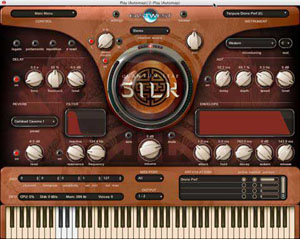Review: Quantum Leap Silk Virtual Instrument
While Quantum Leap Silk is not the newest sample-based virtual instrument (VI) out there, you can take this as a kind of year-end shout to one of my favorite tools of the year. Silk encompasses traditional acoustic instruments from the Silk Road trade route first established during the time of Ghengis Khan, spanning China, India and Persia.
Make the Pilgrimage
As is customary with Quantum Leap’s sample-based instruments using its proprietary Play 32-bit/64-bit interface, Silk comes with a large and comprehensive sound library: 25GB of multi-samples and performances spanning four DVDs. You can install that sizable chunk of sounds to an external drive if you wish, while installing the software itself to your local drive. Authorization requires entering a license code and an iLok USB key. After that, you can open Silk as a standalone instrument or as an Audio Unit or VST plug-in in your host software for Mac or PC (64-bit PC VST support is included).
Quantum Leap founder and composer Nick Phoenix produced Silk, recording world-reknowned masters of the represented instruments both at EastWest and Capitol Studios in L.A., using vintage Neumanm mics and Neve consoles. There are 25 main instrument groups, most of which are string or wind instruments. Some highlights include electric cello, duduk and 30-piece string section from Persia; dilruba, sarod and tanpura strings from India; and multiple string, wind and brass instruments from China. There are no percussion instruments included, which some may find disappointing. However, I understand that trying to include a comprehensive percussion selection from these regions would be a whole other ball of wax requiring a second gigantic sound library, which is not realistic in a single product.
Kick off Your Shoes; Kick out the Jams
Quantum Leap’s proprietary Play hosting environment for sampled VIs presents a straightforward interface for the company’s products, and serves to concentrate on the expertly recorded and performed sounds rather than endless customization. (However, if you want the deep sample-editing features, you can upgrade to the Play II engine.) The Play interface includes a 5-stage envelope, resonant filter, delay, a beautiful-sounding convolution reverb and instrument layering capabilities, among other features. As the convolution reverb can be processor intensive, there is a CPU usage monitor built right into Silk, so you’ll know if you need to turn off the reverb or print your performance to an audio track in your DAW.
If you’re anything like me, you salivate at the chance to include these authentic ethnic instruments in your downtempo electronic pieces, creative floor-filling jams or any musical scores calling for sounds from the Middle East to Indian sub-continent to Far East, but you have no grasp of how to authentically wield such instruments. Silk includes a clever “cheat” for such neophytes by way of its Microtuning section. This is where you choose from a menu of 46 microtunings (including multiple Arabic, Indian, Chinese and African tunings), as well as the key you want to work in, and from there, any note you play will be automatically transposed to a note that works within that tuning and scale. It’s not only an excellent shortcut, but also a way to train your ear to know what works.
A second critical aspect to Silk, and a feature that justifies the size of the library, is that Quantum Leap has sampled different authentic transitions between the notes, such as legato intervals that you can control with a keyboard’s mod wheel. Even without using the mod wheel, many patches use scripts that automatically create effects such as portamento between notes.
Sound Meditations
I can attest that of all the many sample libraries I’ve explored, I’ve never heard Silk’s equal for the traditional string and wind instruments that it represents. If you want your pieces to exhibit the heat of the sun-baked Fertile Crescent or the chill of the snow-topped Himalayas, Silk is a composer’s dream.
Many of these patches will absolutely trick the listener into believing you hired the Shaolin Monks’ touring orchestra to bless your recordings, however, there is still a synthy sheen on some of the wind instruments that may stick out to the savvy listener. For one example, pay close attention to the lead line at the beginning of the “Pan Gu” demo below.
Click here for Silk demos from Quantum Leap, or listen below:
“Pan Gu”
Listen to “Pan Gu” here!
“Raga Girija”
Listen to “Raga Girija” here!
“Nebuchadrezzar”
Listen to “Nebuchadrezzar” here!
Namaste
At a $595 list price, Silk definitely carries the cost of a professional-level sound library and virtual instrument. But you get what you pay for. Besides a few isolated instances of patches that audibly display a digital edge, it is far more often the case that Silk’s sounds will grant you the same satisfaction as a morning sun salutation at a hillside yoga ashram. Since I’ve started using Silk, I could swear I’ve heard its sounds everywhere from cable documentaries to the videogame score of Uncharted 2: Among Thieves. Once Silk lets the genie out of the bottle and unleashes its power on your music, you won’t want to put it back.
–Markkus Rovito is a writer, musician, DJ and contributing editor at http://www.djtechtools.com.
Please note: When you buy products through links on this page, we may earn an affiliate commission.








